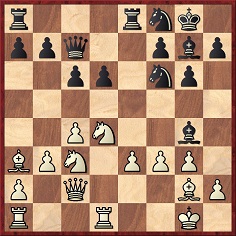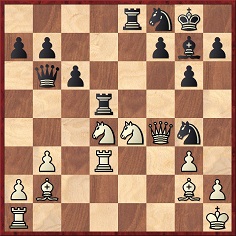Chess Notes
Edward Winter
When contacting us by e-mail, correspondents are asked to include their name and full postal address and, when providing information, to quote exact book and magazine sources. The word ‘chess’ needs to appear in the subject-line or in the message itself.
| First column | << previous | Archives [155] | next >> | Current column |
10467. Reuben Fine
To the range of reports on Reuben Fine’s absence from the 1948 world title match-tournament set out in Interregnum, Christian Sánchez (Rosario, Argentina) adds the following from page 123 of Chess World, 1 June 1948:
‘Arthur Krivis answers in Moscow News the much asked question, why didn’t Fine go?
“The story of the missing contender is a sad one indeed. Grandmaster Reuben Fine, one of the world’s outstanding players, has been compelled to throw away an opportunity that perhaps comes once in a lifetime to vie for world honors because, as the report states, he could not find anyone to take his place at the university for the duration and would not have had the funds to pay a substitute had he found one.
I do not know the particulars of the case but it seems strange that the university authorities where he teaches did not make a real effort to find a pinch-hitter or offer to foot the bill. They left it to Mr Fine as a matter concerning him and him only. But is it really a private matter? Is not Fine a representative of the American people, one of the two Americans honored by the FIDE invitation to contend for the world crown? Or perhaps this is not a sphere of activity that has the blessing of the department headed by Mr Forrestal.
At any rate, we understand Mr Fine’s dilemma. He has a contract with the university which he is honor-bound to fulfill and, besides, a job in the United States is nothing to be sneered at. What was he to do without the patronage of a rich chess daddy – play and lose his job, or hold on to it and give up his fond dream of taking a shot at the world crown? Since the two are often incompatible abroad, the grandmaster made his choice. This could never happen here.”’
10468. Jerzy Giżycki
A number of items (most recently C.N. 10442) have mentioned A History of Chess by Jerzy Giżycki (London, 1972). The original Polish edition was Z szachami przez wieki i kraje (Warsaw, 1960):

John Roycroft (London) writes:
‘Significant personal details about Jerzy Mikolaj Ordon Giżycki may be found in The Spy Who Loved by Clare Mulley (London, 2012), the biography of Krystyna Skarbek, who was better known as Christine Granville, “Britain’s First Female Special Agent of the Second World War”. Giżycki was her second husband.
The well-indexed and meticulously researched illustrated biography has 426 pages, and the adventurous parts make unusually gripping reading. Chess is mentioned just once, on page 344.’

From the index (page 416):
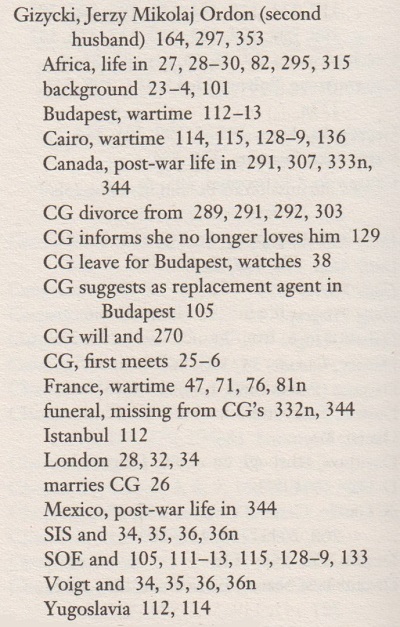
Below is page 297 of volume one of the chess encyclopaedia which Giżycki co-wrote with Władysław Litmanowicz, Szachy od A do Z (Warsaw, 1986):

Afterword (4 June 2017): see, however, C.N. 10472 below.
10469. Villeneuve-Esclapon
A portrait from opposite page 152 of L’Echiquier, April 1929:
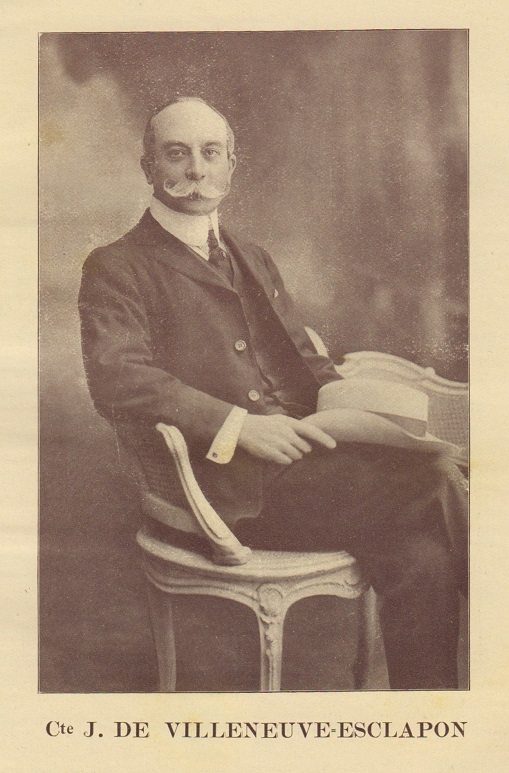
From pages 164-165:


The additional studies mentioned were published on pages 168-170 of the same issue.
10470. Reuben Fine (C.N. 10467)
Olimpiu G. Urcan (Singapore) forwards a report from page 1 of the 5 March 1948 issue of the Daily Trojan, a USC student publication digitally available in the University of Southern California Historical Collection:
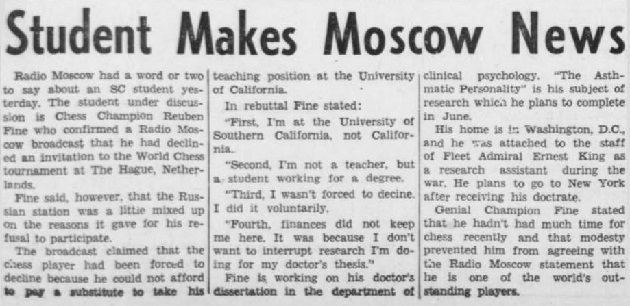
10471. Fine’s doctorate
Mr Urcan also notes that the website mentioned in the previous item has the full text of Reuben Fine’s PhD dissertation, ‘A quantitative study of personality factors related to bronchial asthma in children’ (April 1948).
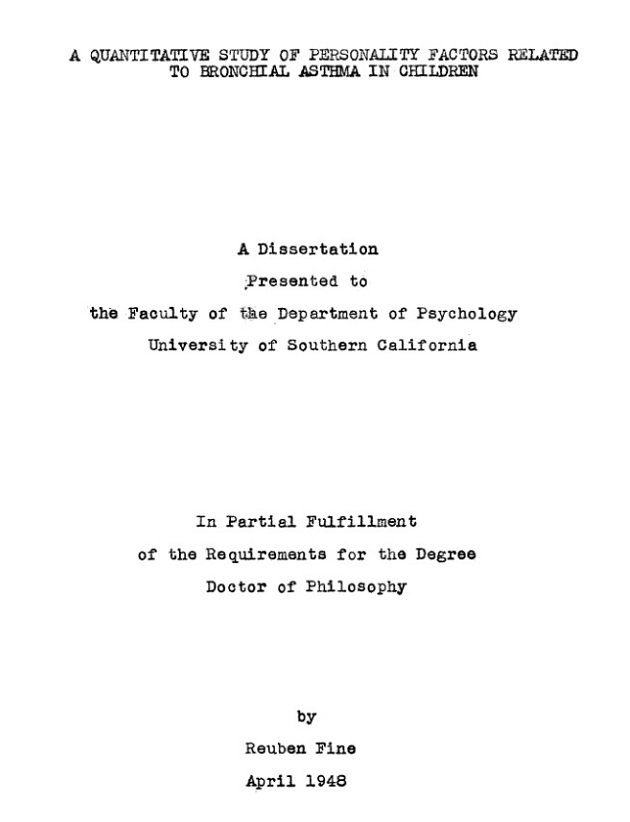
See too our feature article Reuben Fine, Chess and Psychology.
10472. Jerzy Giżycki (C.N. 10468)
C.N. 10468 showed the statement on page 344 of The Spy Who Loved by Clare Mulley (London, 2012) that Jerzy Mikolaj Ordon Giżycki ‘ended his days writing books on chess’, but Michael Mark (London) notes that she appears to have mixed up two people with the same name. Indeed, the Jerzy Giżycki who married Krystyna Skarbek was about 20 years older than the well-known chess writer Jerzy Giżycki.
10473. Problem prodigies
Robert Coffman (St Paul, MN, USA) takes up the reference in C.N. 3402 (see page 223 of Chess Facts and Fables and Chess Prodigies) to two young composers, brother and sister, who were named as Simon and Blanca [sic] Fleischman [sic]. On page 178 of the Scientific American Supplement, 19 January 1878 Sam Loyd wrote that ‘they have both developed a remarkable aptitude for chess’.
Our correspondent notes this composition on page 63 of The Globe, July 1875:
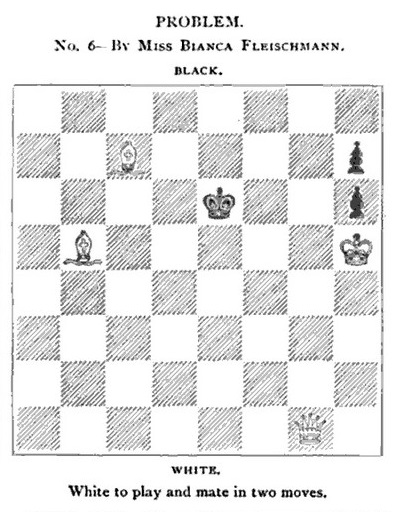
From the following page:

The solution was on page 80 of the August 1875 issue.
We can add that a search of local newspapers indicates that the composers were Bianca Fleischmann (1862-1957) and Simon Fleischmann (1859-1930).

Page 34 (Section III) of the Buffalo Evening News, 22 March 1957


Pages 1 and 2 of the Buffalo Courier-Express, 2 September 1930
The Globe chess column mentioned by Mr Coffman is also in the Jack O’Keefe Project. Problems by Simon Fleischmann appeared in October 1875, November 1875, February 1876 and November 1876. The last of these included, on page 112, a reference to his sister:

10474. Fischer v Moore
A game previously unknown to us:
Bobby Fischer (simultaneous) – Robert W. Moore
Los Angeles, 1 February 1961
Sicilian Defence
1 e4 c5 2 Nf3 d6 3 d4 cxd4 4 Nxd4 Nf6 5 Nc3 a6 6 Bg5 e6 7 Qf3 Be7 8 O-O-O Nbd7 9 Rg1 O-O 10 g4 Qc7 11 Be3 b5 12 g5 Ne5 13 Qh3 Ne8 14 f4 Nc4 15 Bxc4 Qxc4 16 a3 g6
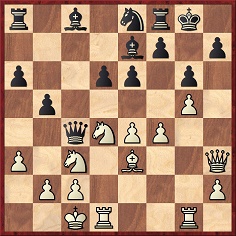
17 f5 exf5 18 exf5 Ng7 19 Qf3 Bxf5 20 Nd5 Rae8 21 Nf6+ Bxf6 22 gxf6 Be4 23 Qf2 Nf5 24 Nxf5 Bxf5 25 Bh6 Re2 26 Qxf5 Qa2 27 White resigns.
Source: Press Democrat (Santa Rosa, CA), 9 July 1961, page 6E (syndicated column by G. Koltanowski).
The 50-board display is discussed, with Robert W. Moore named as one of the three winners, on pages 66-67 of The Unknown Bobby Fischer by J. Donaldson and E. Tangborn (Seattle, 1999).
10475. Nullification (C.N. 8731)
An older appearance of the Al Horowitz remark about 40 good moves comes from his column on page 34 of the Saturday Review, 31 October 1959:
‘It is axiomatic in chess that it is easier to achieve a winning game than to win it. One bad move nullifies 40 good ones, and precision technique is of the essence even when the game is well in hand.’
The full column was reproduced on pages 41-42 of Horowitz’s book All About Chess (New York, 1971).
10476. Herman Steiner
Eduardo Bauzá Mercére (New York, NY, USA) sends two games published by Herman Steiner on page 7 of the second part of the Los Angeles Times, 20 October 1940. Both were played in the 1928 International Team Tournament.
Herman Steiner (USA) – Louis
Betbeder (France)
The Hague, 25 July 1928
Queen’s Gambit Declined
1 d4 Nf6 2 Nf3 e6 3 c4 d5 4 Nc3 Nbd7 5 Bg5 Be7 6 e3 O-O 7 Rc1 a6 8 cxd5 exd5 9 Bd3 Re8 10 O-O c6 11 h3 Bd6 12 Ne2 Nf8 13 Qc2 Bd7 14 Bf4 Bxf4 15 Nxf4 Ne4 16 Ne5 f6 17 Nxd7 Qxd7 18 Kh2 Qc7 19 g3 Rad8 20 b4 Qf7 21 a4 g5 22 Ng2 f5 23 f3 Nd6 24 Rce1 Re6 25 e4 f4 26 gxf4 gxf4 27 e5 Nc4 28 Bf5 Ng6 29 Rg1 Kh8 30 Bxe6 Qxe6 31 Qf2 Rf8 32 Nh4 Ne3 33 Nxg6+ hxg6 34 Qh4+ Kg7 35 b5 axb5 36 axb5 Nc2

37 Rxg6+ Kxg6 38 Rg1+ Kf7 39 Qh7+ Ke8 40 Qxc2 c5 41 dxc5 Qxe5 42 Rg2 Kd8 43 c6 Rh8 44 Qg6 bxc6 45 bxc6 Resigns.
Jacob Erhard Wilhjelm Gemzøe (Denmark) – Herman
Steiner (USA)
The Hague, 3 August 1928
Ruy López
1 e4 e5 2 Nf3 Nc6 3 Bb5 a6 4 Ba4 Nf6 5 O-O Be7 6 Re1 d6 7 c3 b5 8 Bc2 Bg4 9 h3 Bxf3 10 Qxf3 O-O 11 d3 Re8 12 Nd2 Bf8 13 Nf1 Ne7 14 g4 Ng6 15 Bb3 h6 16 Qg3 Qd7 17 Nh2 c5 18 h4 Be7 19 h5 Nf8 20 f3 d5 21 Bc2 Bd6 22 Kh1 Ne6 23 Rg1 d4 24 Qh4 Nh7 25 Qf2 Nhg5 26 Qg2
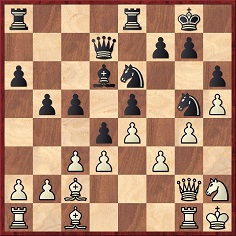
26...c4 27 Rd1 Rac8 28 dxc4 bxc4 29 Bd2 d3 30 Bb1 Nc5 31 b3 Nge6 32 Qf1 Be7 33 Be3 Red8 34 bxc4 Bg5 35 Bxg5 hxg5 36 a3 Nf4 37 Ra2 Qa4 38 Qe1 Ne2 39 Nf1 Nxc3 40 Rad2 Nxd1 41 Rxd1 Qxa3 42 Ne3 Rb8 43 Nd5 Rb2 44 Qf1 d2 45 Ne7+ Kh7 46 h6 g6 47 Kg2 Rdb8 48 Qh1 Ne6 49 Nd5 Qb3 50 Nf6+ Kh8 51 White resigns.
10477. The Capablancas

Source: Philadelphia Inquirer, 14 November 1922, page 17.
10478. Reshevsky and Black
From page 70 of Chess Review, March 1952:

The players in the foreground are Samuel Reshevsky and Roy T. Black, the occasion being specified as a simultaneous display by the former at the Queen City Chess Club in Buffalo, NY. Roy T. Black’s game was the last to finish. A news item on page 67 stated that ‘34 players went down in defeat, while two [including Roy T. Black] held Reshevsky at bay to halve the points’.
Two local newspapers had slightly different information:
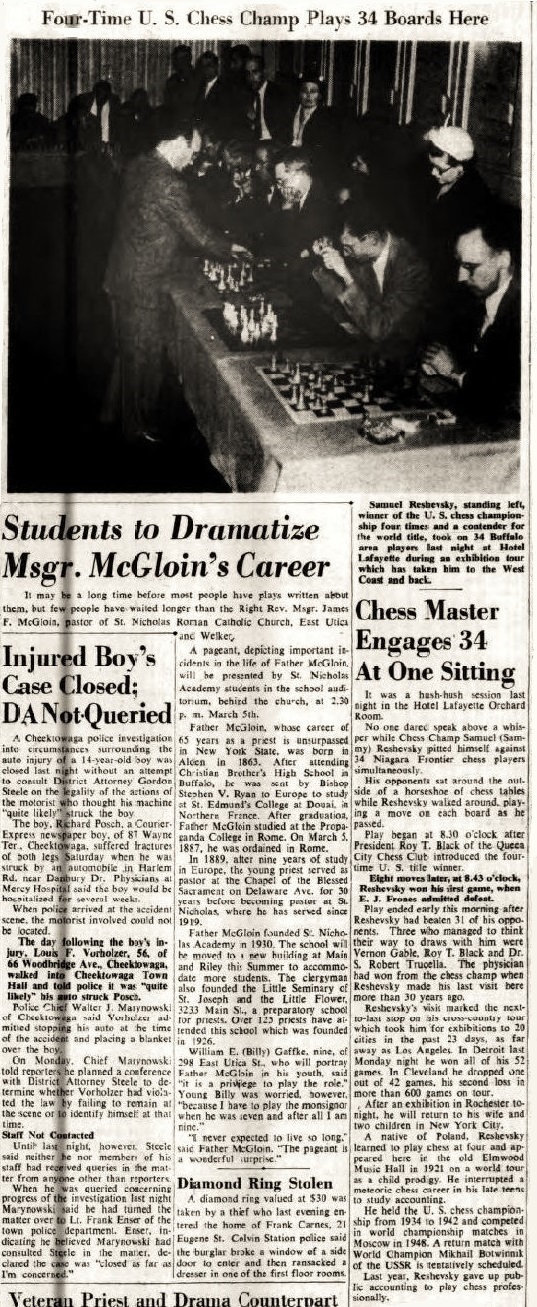
Buffalo Courier-Express, 14 February 1952, page 19
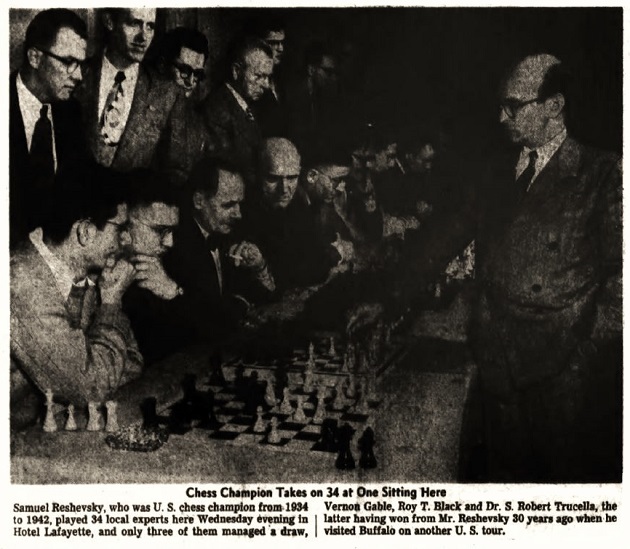
Buffalo Evening News, 14 February 1952, page 52
Both Reshevsky and Black had a win against Capablanca. At the end of a postcard dated 15 September 1988 Reshevsky reminded us of his record against the Cuban:
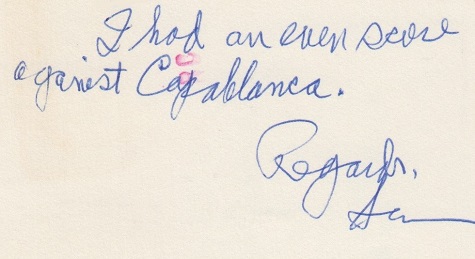
Roy T. Black’s victory over Capablanca was discussed in C.N. 6239.
10479. From former times (C.N.s 10163 & 10419)

Source: page 13 of “Among These Mates” by Chielamangus (Sydney, 1939).
10480. Chess Springbok
The remark in C.N. 10475 about winning a won game reminds us of an excellent passage on pages 2-3 of Chess Springbok by Wolfgang Heidenfeld (Cape Town, 1955), an annotated collection of 25 games:
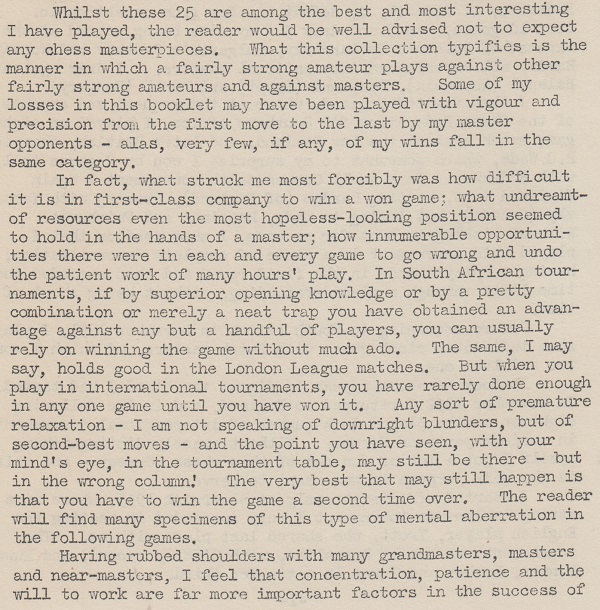

10481. Gleanings from Chess Springbok
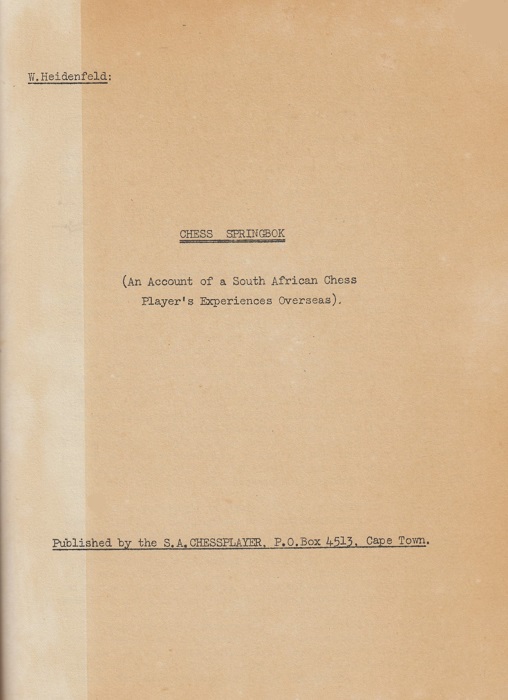
In the penultimate paragraph of the Introduction to Chess Springbok (page 3) Wolfgang Heidenfeld wrote that the book aimed to be ‘a chatty and amusing diary of failure’. Some gleanings:
- Page 4: ‘In Prague I visited what I believe is the only shop in the world completely devoted to chess. It is situated on the famous Vaclanske Namesti (Wenzelsplatz) and run by Erwin Rosenblatt, himself a player of almost master strength.’ [For Vaclanske Namesti read Václavské náměstí.]
- Page 9: ‘As a result of the upheaval in Europe, many minor European masters and near-masters are now resident in England, lending colour and variety to the British chesscape.’ [‘Chesscape’ will be an addition to Chessy Words.]
- Page 9: ‘Lasker’s former training partner, Dr Paul List.’ [What is known about their relationship? We can say only that page 1031 of the Forster/Hansen/Negele book on Lasker has a photograph with this caption: ‘Doppelsimultan von Emanuel Lasker und Paul M. List am 27. April 1929 in der Konditorei Wien am Berliner Kurfürstendamm. Das Team erzielte an 42 Brettern ein Resultat von +32 –2 =8.’ ]
- Pages 11-12: From Heidenfeld’s win over R.G. Wade, fourth match-game, Paignton, September 1951:
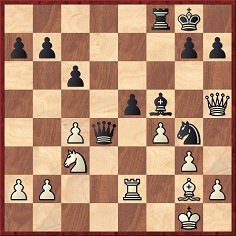
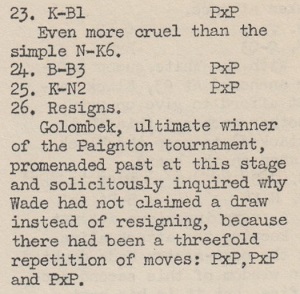
The full game-score: 1 c4 f5 2 d4 Nf6 3 g3 e6 4 Bg2 Bb4+ 5 Bd2 Qe7 6 e3 O-O 7 Ne2 Bxd2+ 8 Nxd2 d6 9 Qc2 e5 10 dxe5 dxe5 11 e4 Nc6 12 O-O fxe4 13 Nxe4 Bf5 14 N2c3 Nd4 15 Qd1 c6 16 f4 Rad8 17 Nxf6+ Qxf6 18 Qh5 Nc2 19 Rad1 Ne3 20 Rxd8 Qxd8 21 Rf2 Ng4 22 Re2 Qd4+ 23 Kf1 exf4 24 Bf3 fxg3 25 Kg2 gxh2 26 White resigns.
- Pages 32-34: ‘I played the “game of my life” in my second encounter with Spanjaard.’ This game, from a match in Utrecht in March 1954, was another win by Heidenfeld as Black:
1 Nf3 Nf6 2 g3 g6 3 Bg2 Bg7 4 O-O O-O 5 d4 d6 6 c4 Nbd7 7 Nc3 e5 8 e3 c6 9 Qc2 Re8 10 Rd1 Qc7 11 b3 Nf8 12 Ba3 exd4 13 Nxd4 Bg4 14 f3
14...Rad8 15 fxg4 Nxg4 16 Rd3 Nxe3 17 Qd2 Qa5 18 Bb2 Ng4 19 Ne4 Qb6 20 Kh1 d5 21 cxd5 Rxd5 22 Qf4
22...Rxd4 23 Rf1 f5 24 Bxd4 Bxd4 25 h3 Ne6 26 Qf3 Ne5 27 Nf6+ Kf7 28 Nd5 cxd5 29 Qxd5 Nxd3 ‘and White resigned after a few “shadow” moves’. The game was also annotated by Heidenfeld on pages 36-38 of Lacking the Master Touch (Cape Town, 1970).
- Page 37: ‘The grand old man of Italian chess is Esteban Canal, originally of Peru, who at the age of 57 won the 1953 Venice tournament to which I had the good luck of being invited. He is one of the most interesting and amusing of all chess personalities. Formerly a roving reporter, he speaks six or seven languages and still treasures mementos of such VIPs as Kemal Pasha and Ab del Krim. He is an inexhaustible raconteur of chess stories.’
- Page 39: ‘Chess – even among masters and near-masters – is a lottery. The only difference between it and a real lottery is that at our game there are as many winners as losers.’
The four pages of plates include this photograph:
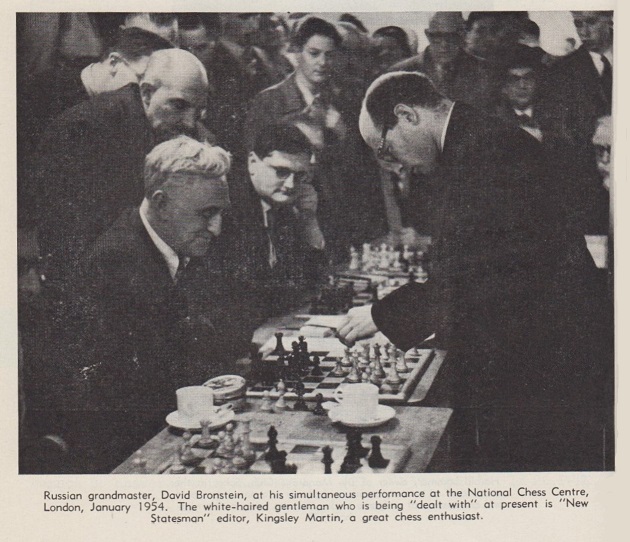
10482. The Raubitschek brothers (C.N.s 7139 & 7155)
The odds game below is from page 54 of the March 1921 American Chess Bulletin:

1 e4 e5 2 Bc4 Nf6 3 Nc3 c6 4 d4 b5 5 Bb3 b4 6 dxe5 bxc3 7 exf6 Qxf6 8 bxc3 Qxc3+ 9 Bd2 Qe5 10 O-O Be7 11 Qf3 O-O 12 Bc3 Qg5 13 Qe2 Bb7 14 Rad1 d5 15 f4 Bc5+ 16 Kh1 Qe7
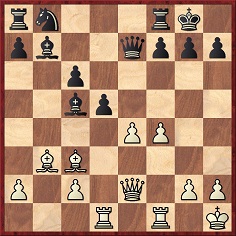
17 Qg4 f6 18 exd5 cxd5 19 Rxd5 Kh8 20 Rd3 Ba6 21 Rh3 g6 22 Re1 Qg7 23 Bd5 Bb7 24 Bxb7 Qxb7 25 Qxg6 Qg7 26 Bxf6 Rxf6 27 Re8+ Bf8 28 Rxh7+ Qxh7 29 Qxf6+ Qg7 30 Rxf8+ Kh7 31 Rf7 Resigns.
10483. An interview with Pillsbury
From page 9 of the Pall Mall Gazette, 27 May 1902:
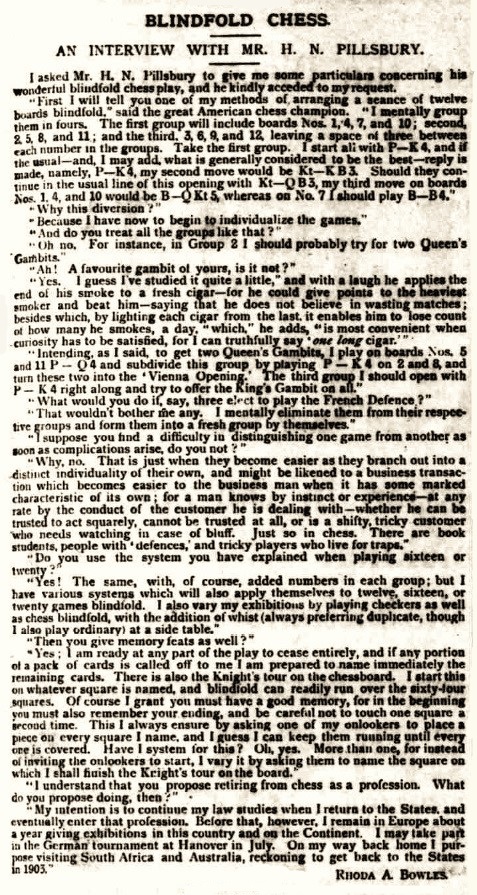
This interview by Rhoda A. Bowles was reproduced by her on pages 344-346 of the August 1902 BCM. A photograph of her with Pillsbury’s wife is in C.N. 9458.
10484. A Pollock miscellany
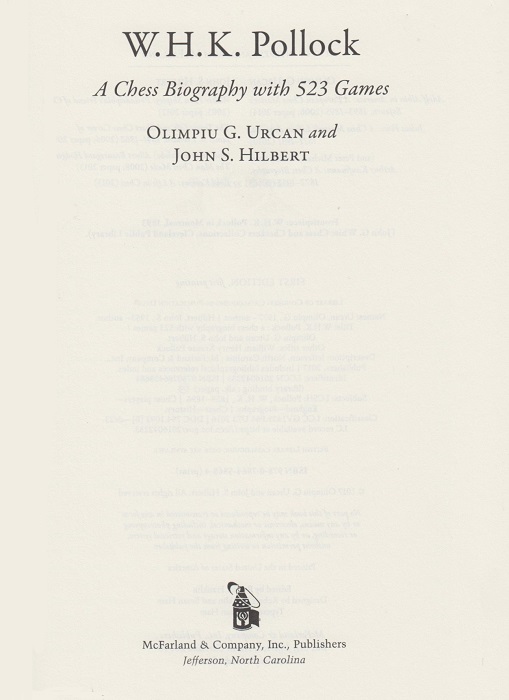
From the recent book W.H.K. Pollock. A Chess Biography with 523 Games by Olimpiu G. Urcan and John S. Hilbert (C.N. 10459) we note some matters of relevance to C.N. items:
Chigorin’s height has been discussed in C.N.s 1106, 7879 and 9718. A footnote on page 127 of the book has a quotation from the Brooklyn Standard-Union, 2 April 1892:
‘Mr Chigorin is about five feet seven inches in height, with very dark hair and fair skin; high forehead, and with a general air of prosperity about him that is quite pleasing to chess players. He has a bright, kindly eye that looks directly to the questioners and his handshaking has that warm, brotherly pressure that draws one to him.’
This may be compared with the description on page 186, cited from the October 1895 BCM:
‘... M. Chigorin, the Russian master, of moderate height, well-knit frame, dark olive complexion, high round forehead, jet black hair and most penetrating eyes, very quiet and affable in manner, with hands clasped and the fore part of the arms resting on the table, and whose slight trembling of the right leg resting on the toes indicates the excitement of mind.’
From an annotation by Pollock in 1883 (page 209):
‘The position is very peculiar, and well illustrates Steinitz’s rule, “When you have found a very good move, don’t make it, but look for a better one.”’
Page 413 has an 1894 game annotation by Pollock which reads:
‘Following Steinitz’s principle: “When you have found a good move, don’t make it but look for a better one.”’
This ‘rule’ has been discussed in C.N.s 7837, 7841, 8738, 8890, 9303, 9309 and 10087.
An 1889 note by Pollock on page 333:
‘We base this form of development on the principle that “counter-attack is the soul of defence”, v. Anderssen vs. Morphy, games II and IV of match.’
The quote will be added to The Soul of Chess.
Concerning the ‘Chigorin Variation’ 1 e4 e6 2 Qe2, page 395 of the book gives the game Pollock v Halpern, Staten Island, August 1893, with this note after White’s second move:
‘A seemingly new idea by Pollock which was later used extensively by Chigorin in important matches and tournaments. In annotating the second game of the Chigorin vs. Tarrasch 1893 match, in his 19 November 1893 Baltimore Sunday News column, Pollock wrote about 2 Qe2: “Introduced by the Editor. See News 19 August. The object is to stop …d5. Mason calls it ‘but a harmless violation of principle, yielding a strange game, a confusion of the Sicilian, Fianchetto and French.’” While annotating the same game for the 25 October 1893 New York Sun, Chigorin said nothing about 2 Qe2. However, the newspaper columnist remarked: “Chigorin introduced a novel move in the French game, namely 2 Qe2, and as a matter of course the game becomes doubly interesting, inasmuch as it might completely alter the theory of this defence. Chigorin in his notes, taken especially for the Sun, does not make any remarks regarding the move.” The 27 October 1893 edition of the Sun published the following from Pollock: “To the editor of the Sun: Sir: The move of 2 Qe2 in the French defence, which in your admirable report of today is described as novel and introduced by Chigorin, was played by myself against J. Halpern in the recent Staten Island cup tournament. Yours respectfully, W.H.K. Pollock.”’
Page 450 quotes from an article by Pollock in the Christmas 1893 issue of the BCM:
‘It was on Staten Island that I invented and discovered the move of 2 Qe2 in the French, since “spoiled” by the hibernations of the bear in the St Petersburg match. My old Richmond (Va) friend of the Daily News, and other London players, decry the move as inducing, instead of seducing the “Frenchman” to reply …d5.’
Page 473 has a book review by Pollock in the Baltimore Sunday News, 23 September 1893 which provides an addition to Chessy Words:
‘A perusal of this painstaking work would repay any lover of the game, but something written in original style, even if not original in premises, will always go further than compilations from books. A chess-smith, too, must go into the forge and strike the iron on its white-hot places; he has no time to forage around for pieces of old metal to burnish up and weld into marketable shape – they are too thin and twisted and torn for use.’
10485. Villeneuve-Esclapon (C.N. 10469)
Eduardo Bauzá Mercére (New York, NY, USA) draws attention to a game on page 110 of La Stratégie, 18 April 1905:
Frank James Marshall (simultaneous) – Count Jean de
Villeneuve-Esclapon
Café de la Régence, Paris, 11 March 1905
Sicilian Defence
1 e4 c5 2 d4 cxd4 3 Nf3 Nc6 4 Bc4 e6 5 Nxd4 d5 6 exd5 exd5 7 Bb5 Bd7 8 O-O Bc5 9 Re1+ Nge7 10 Nxc6 bxc6 11 Bd3 O-O 12 Qh5 Ng6 13 Nc3 f5 14 Bg5 Qb6 15 Be3 d4 16 Na4
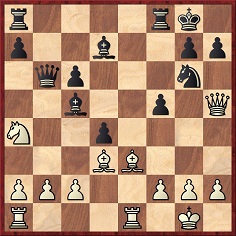
16...dxe3 17 Nxb6 exf2+ 18 Kh1 fxe1(Q)+ 19 Rxe1 axb6 20 h3 Nf4 21 Bc4+ Kh8 22 Qg5 Nd5 23 a3 h6 24 Qg6 Rf6 25 Qg3 f4 26 Qf3 Raf8 27 Bxd5 cxd5 28 Qxd5 Bc6 29 Qc4 f3 30 gxf3 Rxf3 31 Kh2 Rf2+ 32 Kg3 Rg2+ 33 Kh4 Bf2+ 34 Kh5 Rf5 mate.
We add a report on the display from page 89 of the 17 March 1905 issue of La Stratégie:

10486. Frank Marshall photographs
Three photographs of Marshall by Hansel Mieth dated December 1939 can be viewed online: 116539986, 116540000, and 116540002.
10487. Alexander v Kashdan
From page 8 of All About Chess by I.A. Horowitz (New York, 1971):

I. Kashdan’s victory over C.H.O’D. Alexander (Stockholm, 12 August 1937): 1 e4 e5 2 Nf3 Nc6 3 Bb5 a6 4 Ba4 Nf6 5 O-O d6 6 Bxc6+ bxc6 7 d4 Nd7 8 b3 Be7 9 Bb2 f6 10 Nh4 g6 11 Qe2 f5 12 dxe5 Bxh4 13 e6 Nf6 14 Qc4 c5 15 e5 Ng4 16 Qd5 Rb8 17 exd6 Bb7 18 d7+ Kf8 19 Qc4 Bf6 20 Bxf6 Nxf6 21 Qxc5+ Kg7 22 Nc3 Ng8 23 Rad1 h6 24 Rfe1 Ne7 25 Qe5+ Kh7 26 Na4 Rf8 27 f4 Rg8 28 Nc5 g5 29 Nxb7 Rxb7 30 c4 gxf4 31 Qxf4 Rg6 32 Qh4 Rb8 33 Re5 Qf8 34 Qf2 Rd8 35 Qc5 c6 36 Rf1 Qg7 37 Re2 Rg8 38 g3 Rxg3+ 39 Kh1 Rg6 40 Qb6 Rxe6 41 Rg1 Rxe2 42 Rxg7+ Rxg7 43 h4 Re1+ 44 Kh2 Re2+ 45 Kh3 f4 46 White resigns.
Alexander annotated the game on pages 567-569 of the November 1937 BCM. See too pages 41-44 of The Lost Olympiad Stockholm 1937 by W.H. Cozens (St Leonards on Sea, 1985).
No move in the game corresponds to Horowitz’s reference to a blunder losing a piece. As regards his assertion about the best-score prize offered by Turover, below is a paragraph from page 235 of the October 1937 Chess Review:
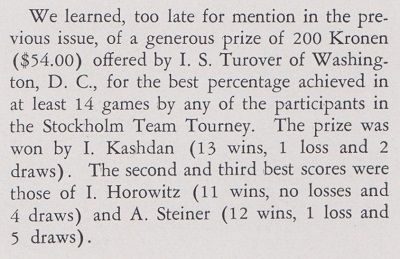
10488. Pillsbury’s single bishop mate (C.N. 2940)
C.N. 2940 (see pages 261-262 of Chess Facts and Fables) quoted from this item on page 208 of Checkmate, December 1901:
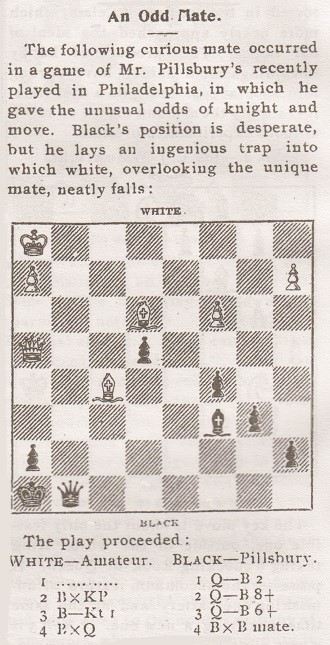
We note that the text is barely different from what appeared on page 19 of the Chicago Tribune, 3 November 1901:
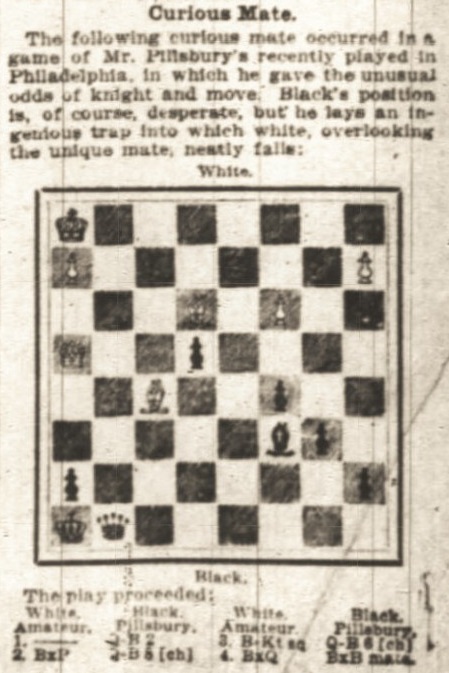
Details about the game, including the full score, are still sought. C.N. 2910 mentioned that the finish had been published in the Literary Digest, 25 November 1899.
10489. Tartakower on Rubinstein
From an article by Tartakower, ‘Secrets of San Remo, 1930’, on pages 421-424 of CHESS, 20 August 1939:
‘Coming second in so important a competition, Nimzowitsch was considered the prince of chess. Nevertheless he was less dangerous to Alekhine throughout the tournament than Rubinstein, who had the chance, two rounds before the end, of catching up with the leader. That is why in the game Alekhine-Rubinstein played in the 14th round – the one before the last – it appeared to be to Alekhine’s advantage to try for a draw, which would give him first prize, rather than chase an uncertain win. When somebody suggested to Rubinstein before the game that he would do well to accept such a pacific situation the great Akiba replied, “A Rubinstein always plays to win”.
Lacking thus a quiet and objective outlook, Rubinstein fell into an opening trap which cost him a pawn and, despite a heroic resistance, the game.’
Concerning that game, see The Rubinstein Trap. With regard to Tartakower’s comments about the standings, it should be noted that before the 14th round Alekhine led with 12 points, followed by Nimzowitsch and Rubinstein (9 points). Alekhine won the tournament by a 3½-point margin.
10490. Eugene Morphy and Sammy Reshevsky
A news item on page 8 of section two of the Pittsburgh Sunday Post, 19 November 1922:
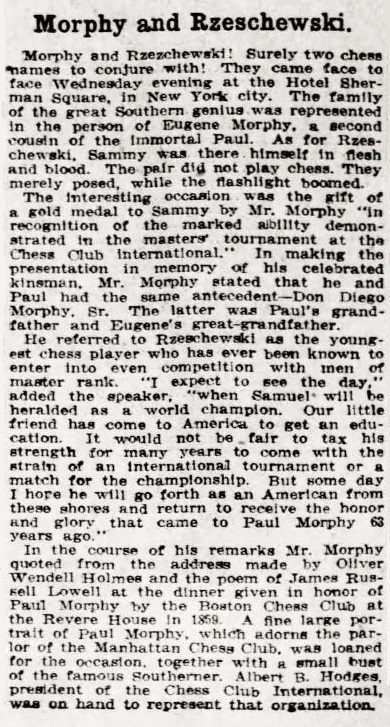
10491. Lasker in Aachen
Thomas Niessen (Aachen, Germany) has found three more Lasker games:
Happich – Emanuel Lasker (simultaneous)
Aachen, 10 November 1913
Vienna Gambit
1 e4 e5 2 Nc3 Nf6 3 f4 d5 4 fxe5 Nxe4 5 Qf3 Nxc3 6 bxc3 Nc6 7 d4 Be7 8 Bf4 O-O 9 Bd3 Be6 10 Ne2 Qd7 11 O-O f5 12 Qg3 Kh8 13 Bg5 h6 14 Bxe7 Nxe7 15 Nf4 c5 16 Nh5 Rf7 17 Rf2 c4 18 Be2 Rg8 19 Qe3 Rgf8 20 Nf4 g5 21 Nxe6 Qxe6 22 Bh5 Rg7 23 Raf1 Rfg8 24 g4 f4 25 Qc1 Ng6 26 Qa3 a6 27 Rb1 Nh4 28 Qc5

28...Rc8 29 Rb6 Rxc5 30 Rxe6 Rc6 31 Rxc6 bxc6 32 e6 Re7 33 Bf7 Kg7 34 Re2 Kf6 35 White resigns.
Source: Aachener Anzeiger – Politisches Tageblatt, 30 November 1913 (evening edition).
Vopel – Emanuel Lasker (simultaneous)
Aachen, 5 February 1925
Sicilian Defence
1 e4 c5 2 d4 cxd4 3 Nf3 e5 4 Bc4 Nc6 5 O-O d6 6 Ng5 Nh6 7 f4 f6 8 Nf3 Nf7 9 c3 dxc3 10 Nxc3 Be7 11 Kh1 O-O 12 f5 Bd7 13 Nh4 Rc8 14 Qh5 Nd4 15 Bd5 Bc6
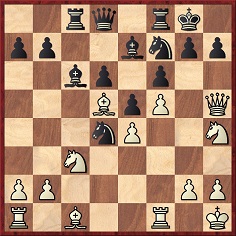
16 Ng6 Bxd5 17 Nxf8 Bc4 18 Ne6 Nxe6 19 fxe6 Bxe6 Drawn.
Source: Aachener Anzeiger – Politisches Tageblatt, 14 February 1925 (midday edition).
Emanuel Lasker (simultaneous) – Dreyfus
Aachen, 5 February 1925
Ruy López
1 e4 e5 2 Nf3 Nc6 3 Bb5 a6 4 Bxc6 dxc6 5 Nc3 Bg4 6 h3 Bxf3 7 Qxf3 Bc5 8 d3 Qf6 9 Be3 Qxf3 10 gxf3 Bd6 11 Ne2 c5 12 f4 f6 13 fxe5 fxe5 14 Rg1 g6

15 f4 b6 16 O-O-O O-O-O 17 Rdf1 Nf6 18 fxe5 Bxe5 19 Bg5 Rd6 20 Bf4 Bxf4+ 21 Nxf4 Nd7 22 Nd5 c6 23 Ne3 Rf6 24 Ng4 Rxf1+ 25 Rxf1 Rf8 26 Rxf8+ Nxf8 Drawn.
Source: Aachener Anzeiger – Politisches Tageblatt, 21 February 1925 (midday edition).
10492. William Beverley’s knight’s tour
From John Townsend (Wokingham, England):
‘The London, Edinburgh and Dublin Philosophical Magazine and Journal of Science (volume XXXIII, July-December 1848, Number CCXX (August), pages 101-105) carried an article by William Beverley containing the first knight’s tour on the magic square theme. The article was reproduced on pages 344-347 of the 1848 Chess Player’s Chronicle.
In the London, Edinburgh and Dublin Philosophical Magazine and Journal of Science Beverley’s address was given as 9 Upper Terrace, Islington, the date of his submission being 5 June 1847.
The National Archives hold the will of
“William Beverley the Elder of 9 Upper Terrace Islington ... Esquire.” (Source: National Archives, PROB 11/2115/406.)
The will was dated 4 January 1845 and named his wife, Eliza, and eldest son, “William Beverley the Younger”. A codicil, dated 13 April 1850, described the testator as “late of Upper Terrace Islington ... but now of Park Terrace Liverpool Road”. The will was proved on 31 July 1850.
William Beverley was buried at St James, St Pancras, on 15 July 1850. His address was given as 9 Park Terrace, Islington, and his age as 68. The Gentleman’s Magazine for 1850 (page 225) contained a short obituary which described him as “William Beverley, esq. late of Her Majesty’s Customs”, indicating that he died on 8 July, and reporting his age as 67.
The 1841 census confirms that he was an “Officer H.M. Customs”, and that he resided then at Colebrooke Row, Islington. His age was given within the range 55 to 59, and it was recorded that he was born within the county of Middlesex (source: National Archives, HO 107 664/3, folio 18). He lived there with Eliza Beverley and five children.
For the reasons given above, it is very likely that he was the William Beverley who was the author of the knight’s tour. Any doubt is confined to whether it could have been his son, “William Beverley the Younger”. A baptism entry in the parish register of St Andrew’s, Holborn, shows that he was born on 1 February 1827 and baptized on 4 April 1827, at a time when the family lived at Hatton Garden. He was thus only 20 years old when the article was submitted.’
10493. Chessy words
Rod Edwards (Victoria, BC, Canada) notes this item on page 2 of the Australasian Supplement, 21 February 1885:

The citation with ‘chesscat’ will be added to Chessy Words. Concerning another term discussed above, ‘cook’, see C.N.s 4341 and 6460.
Our correspondent found the ‘Chess Words’ column on the Trove website of the National Library of Australia. Its earlier publication in Land and Water will be appreciated.
10494. Land and Water
The only substantial Land and Water material in our collection is a 75-page Victorian scrapbook with the columns from 17 May to 15 November 1873 and a four-page handwritten index. The first page:
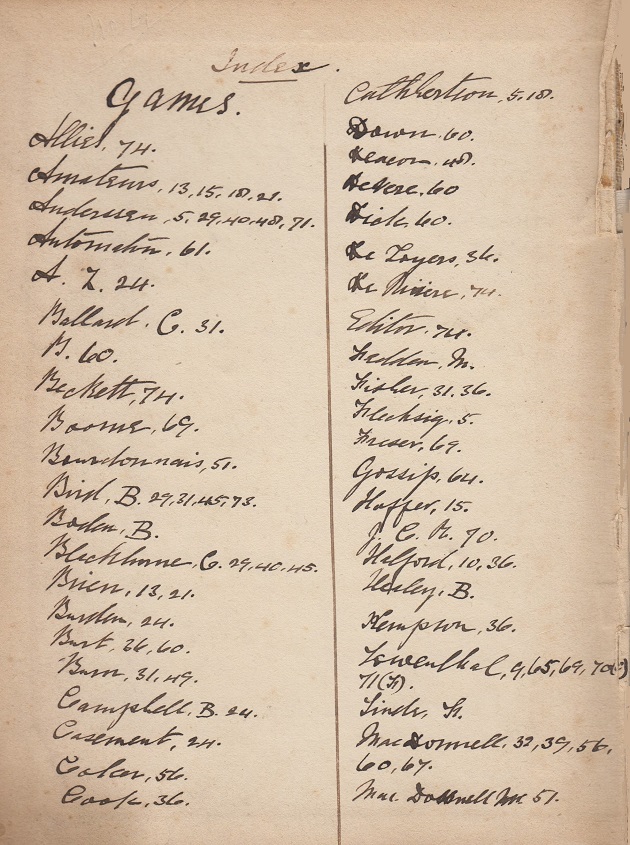
A detailed description of the column was published by ‘J.G.C.’ on pages 365-366 of the October 1885 BCM:
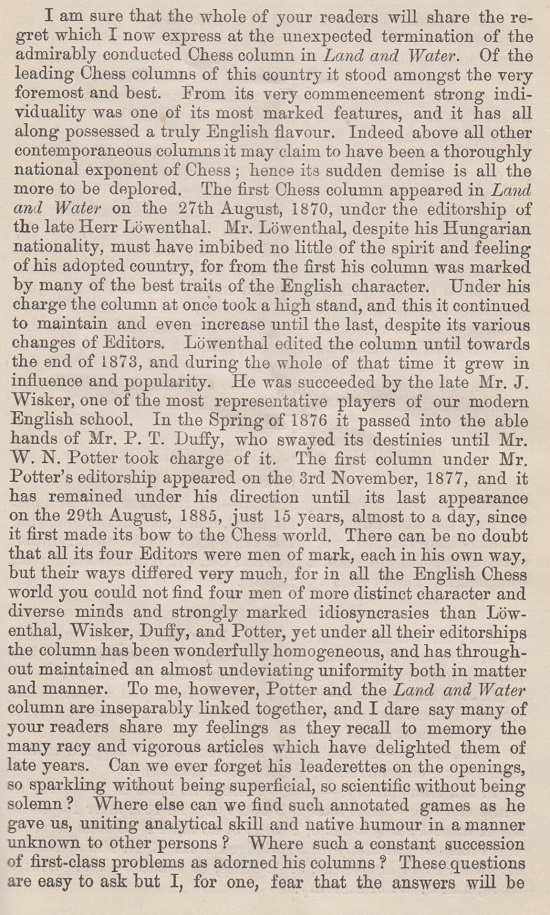
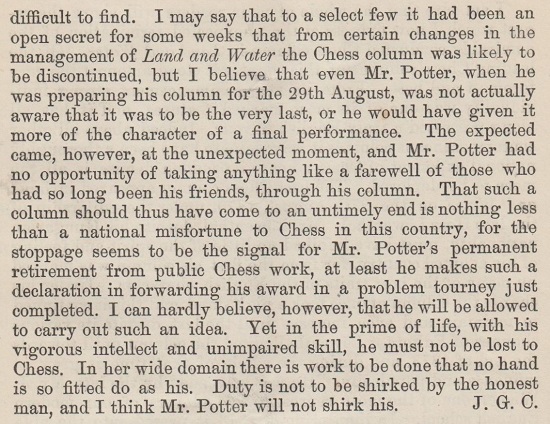
10495. Helmut Dantine and chess
C.N. 7076 (see too Chess and Hollywood) had a reference to Helmut Dantine (1918-82) from page 26 of the October 1945 Chess Review:

Olimpiu G. Urcan (Singapore) provides some further material on the actor:
1) On page 36 of Hollywood, January 1943, Dorothy Haas wrote about Dantine:
‘In addition to writing, his real hobby is chess. He and Humphrey Bogart played every day during the shooting of Casablanca. He likes all active sports and enjoys watching football and baseball.’
The accompanying photograph:

Bogart and Dantine in Casablanca:
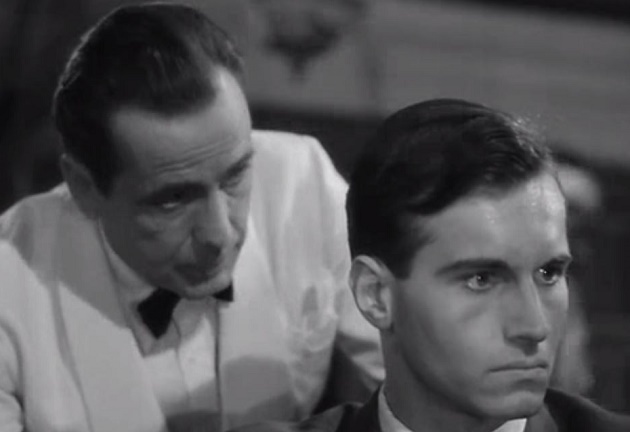
2) From the Long Beach Independent, 4 July 1943, page 16:
‘Helmut Dantine, featured in Warner Bros’ Edge of Darkness, has entered the National Association Chess tourney. Helmut was seventh-ranking player in Vienna.’
3) Modern Screen, June 1944, page 38 had this:
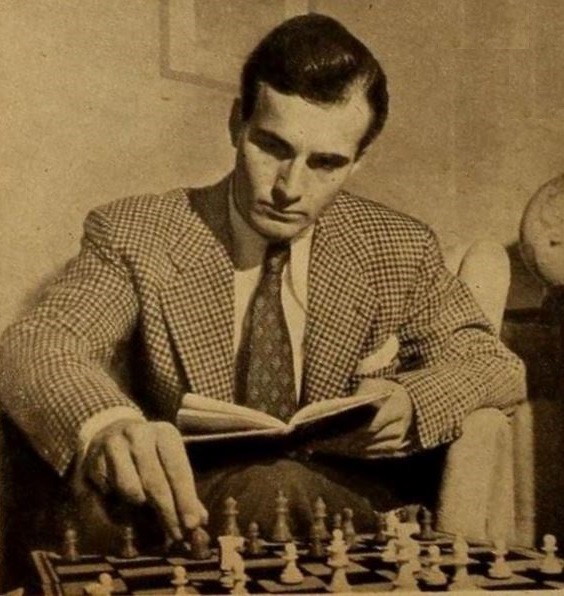
Dantine’s role in Passage to Marseille was featured on page 56 of the same issue of Modern Screen, with this photograph:
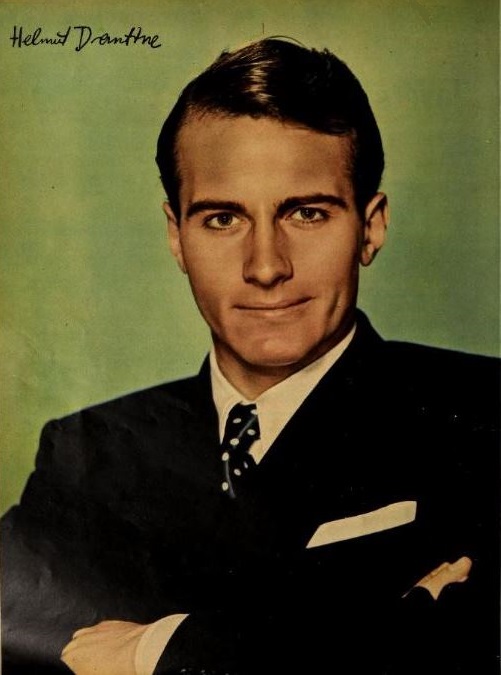
From page 91 (text by Jack Carson):
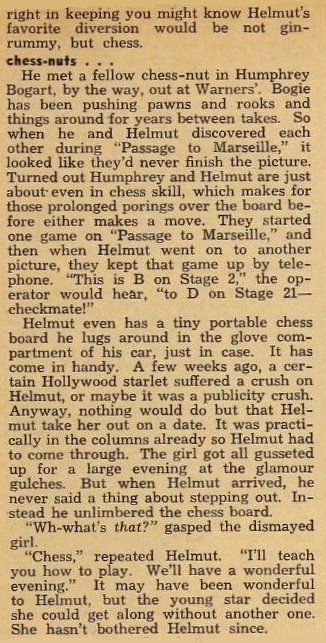
4) A photograph of Dantine and Bogart at the chessboard, with George Tobias and Philip Dorn, was on page 12 of the 14 January 1944 edition of the Salt Lake Tribune. As shown below, it also appeared on page 393 of Chess Life & Review, July 1979:
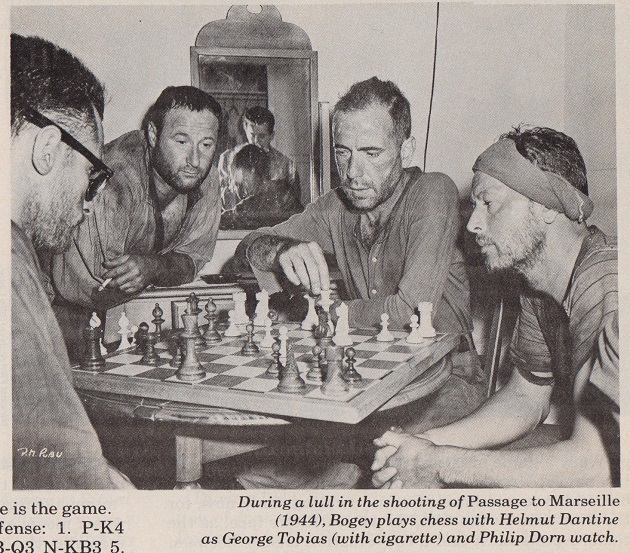
5) From the Olean Times Herald, 27 December 1949, page 7 (and in other newspapers in late December 1949):
‘Helmut Dantine’s prowess at chess makes him puffier than any critics’ praises he ever won at acting. Whenever he’s in New York he can be found haunting the midtown chess parlors, and he’s never so happy as when one of the gray-bearded experts takes him on for a contest. His mail-box gets crammed with communiqués from other chess addicts, and he always has a dozen chess-by-mail opponents following wherever he may travel.’
10496. Mate with one bishop
Our latest feature article is The Single Bishop Mate.
10497. Gerald Abrahams on the 1972 Spassky v Fischer match
Some extracts from ‘Reflections after Reykjavik’ by Gerald Abrahams on pages 84-90 of Encounter, March 1973:
- ‘Journalism is the study of the irrelevant. Through that too bright glass, which when focused disturbs the concentrator on essentials as sorely as the television lights disturbed Bobby Fischer, everything trivial is aggrandized, everything insignificant given a value. Over there, at “the battle of Reykjavik”, there was no dearth of trivia. As Browning might have asked, “Who fished up that maroon suit? What breakfast had the Russ?” In that novel context a plethora of irrelevancies scattered itself around for grubmen to devour and regurgitate; just like mistakes on the chess board, waiting there to be made.’
- ‘... in the lively oracles of the world press, we were shown Might campaigning against Right, or Right against Left – strange analogies for a couple of hard-working Jewish boys “doing the best they could”. Incidentally, they and their companions, coming from Brooklyn and Moscow to Iceland, constituted the first large-scale Jewish immigration in the history of the island.’
- ‘Fischer’s play was described as “relentless” and “ruthless”. This is a splendid example of what Ruskin called “The Pathetic Fallacy”, as when the would-be poet speaks of the “cruel Sea” or the “kindly Vales”. Chess moves are effective or ineffective. A chess move is not cruel when it is good; nor is a bad move intended as an act of kindness.’
- ‘Chess, which is a science of the relevant – everything that journalism is not – was purveyed as news to the avid spectators of meaningless spectacle. These were determined to see a bullfight; and they clothed with appropriate trappings one who was never a bull and another who was never a matador. In fairness, it should be added that Fischer cooperated, away from the board, by baiting FIDE, baiting Iceland, baiting the Soviet Union, attacking the TV promoters, and conducting a first-class war against himself. But the metaphor of the bullring loses everything when one realizes that never at any stage was Fischer hostile to Spassky; whom, in fact, he has always admired.’
- ‘The beauties of chess are in the emotions of the beholder. The dénouement gave pleasure and surprise to the spectator – including the player. But the player was not striving after aesthetic effects – that would be bad chess. He was only concerned to use his material scientifically towards his purpose.
The use by many people of the term “Art” in application to chess is explained by the circumstances that chess is not an “exact Science”, as mathematics and astronomy are exact. (That chess is “not mathematical” I hold to be platitude.) Chess is comparable to the inexact empirical sciences (sometimes called “arts” in the sense of crafts), e.g. engineering, clinical medicine, some fields of chemistry, etc. Because chess is inexact – because to the vision of the player (and vision in his faculty) the board is not always translucent, is more usually opaque, concealing fields of chance – there is scope for judgment. There is also scope for style and there is scope for varieties of excellence. These differences enhance the impression of conflict between players. But as chess approaches asymptotically its scientific ideal, opponents (in the sense of “belligerents”) become unimportant. It is as if two engineers were tunnelling through an Alp. Each is opposed only by the thickness of the mountain and the thinness of his tools. So the chessplayer has no opposition other than the inherent difficulties of the subject matter and the limitations of his own mind. The opponent’s moves are relevant as possibilities which he must anticipate and control, and frequently fails to anticipate and control. The opponent embodies the task. But the opponent is not an ordinary adversary. In chess there is no adversary comparable to the bull or a boxer in a ring, to a batsman, a bowler, a centre-forward or a goal-keeper. Two persons are operating on the same board: each playing his private game against himself. As each one loses, he blames not the other, but himself. Not protagonist and antagonist here, but (a semantically unique case) two protagonists, each accidentally helping to constitute a test for the mental adequacy of the other.
So it is in my theory. As to practice, I only know one great player who behaved as if chess was completely “objective”. That was Akiva Rubinstein – a talmudist turned chessplayer. He was been called the “Spinoza of Chess”. But if you told this to the average super grandmaster (who has no metaphysics in his mind or music in his soul) he would ask “What tournaments did Spinoza win?” ...’
- ‘The match was probably “the most human” chess contest that has ever been staged. Fischer, starting in the grip of a nervous breakdown, handicapped himself as no world contestant has ever done.’
- ‘[Fischer] came to the board (rather late) in the third round and produced a masterpiece. He seemed detached, somnambulistically, from all that had gone before.
The famous Kt-R4 in that game may have seemed to Spassky to be a gamble; but there was profound and original thought involved in it. One is reminded of that fact that the immortal attack with which Fischer, playing Black, defeated Donald Byrne nearly 20 years ago, commenced with a sacrificial Kt-R5. If Fischer has a style, under his versatility, it seems to be characterized by clever knight play, and there was plenty in this match. In this respect he resembles Alekhine rather than Capablanca ...
In this game Fischer gave the friendly critic many reasons for admiration. First, he showed that chess strategy can be dynamic: not only knowing what to do when there is nothing to do; but a line of thought in which the tactics and the shaping of the game are integrated in purposeful play, involving a clear vision of long and subtle variations. This is great chess.’
- ‘One truth about chess is that memory is more likely to be a handicap than an advantage. There comes a stage in every game when the player has to find not what Botvinnik decided years ago but what he now is called upon to play. Then, if he has been too reliant on memory, he will fail to produce the ideas that constitute bright chess. The windows of his mind are curtained to exclude ideas from floating in. His vision will be limited because he has not sufficiently exercised it. Because of their independence, players like Fischer and Spassky (and they are not the only ones) are convincing refuters of Capablanca’s pessimistic pronouncement, 40 [sic] years ago, that chess would soon be “played out”.’
- ‘Fischer is said to think badly of Lasker. But I permit myself to suggest that he showed Laskerian qualities in two ways: first, in his readiness to accept any offer of material; second (and this is necessitated by the first) in his extraordinary powers of defence against heavy attack, and his ability to emerge with advantage. Perhaps he drove on beyond visibility, but his judgment was always superb.
There are, roughly, two ways of trying to win at chess. The tradition of Morphy, Steinitz, Capablanca and Rubinstein is to develop well and subtly, seizing very slight initiatives, converting them to advantages and the advantages into victory. Like “unheard melodies”, the Sturm und Drang are in the mind only. The other method, the method of Lasker and Alekhine, is to unbalance the game, bringing about skirmishes and hard fighting. There the great combinations are more frequently visible.’
- ‘When Lasker played experimental chess against Tarrasch, it was said by a fine player (Réti) – descending into journalism – that he was “playing the man, not the board”. This was total misunderstanding. But the thought justifies reflection.
Even below the level of ideal chess, good players play the board. A good player will not speak of “laying a trap” for an opponent. He makes a move to which he sees that his opponent cannot make the obvious reply on account of some quite hard-to-see possibility. But he will never make the second best move merely because it gives an opponent an easy chance of error. Good players always make the move that they think to be the best, and they assume that an opponent will not make mistakes.’
- ‘There remains one question. Why has the Chess Crown, since the death of Alekhine, rested on Jewish heads (except when it was borrowed by an Armenian)? To say that it is because there are still many Jews in Russia is not a sufficient explanation.
My own theory is that Jews, through evolutionary processes, have become good at languages. To be good at languages it is desirable to reach maturity early, and grasp the accidence and syntax and important vocabulary at an early age, so that while the mind is still young the student can express himself fluently and with mastery.
Among languages I include mathematics, music and chess. Different inter se, these systems are only grasped creatively by those who early grasp the technique. The particular Jewish control of chess is one instance of this process realized.
As for Fischer’s control of chess, let it simply be said that from now onwards the phrase Grand Master is meaningless.’
10498. From former times
A new feature article ‘From Former Times (Chess)’ collates C.N.s 10163, 10419 and 10479, together with this cartoon from page 187 of the September 1939 Chess Review:
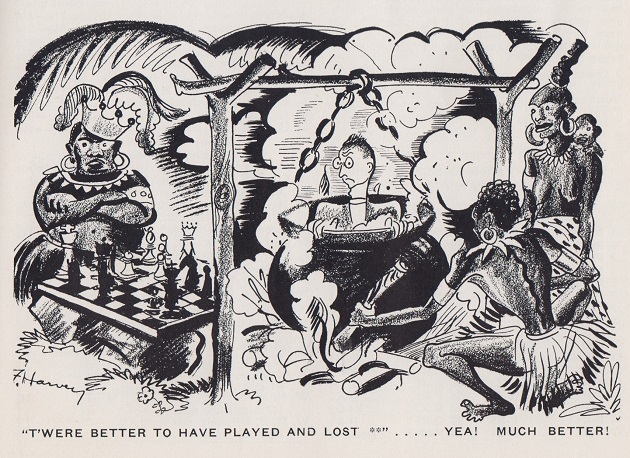
10499. Conrad Veidt (1893-1943)
Mention of Casablanca in the item on Helmut Dantine (C.N. 10495) prompts Edward Hamelrath (Dresden, Germany) to point out a reference to Conrad Veidt on page 379 of the Carlsbad, 1929 tournament book:
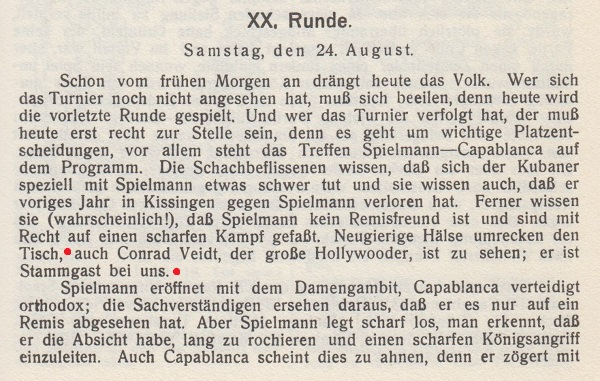
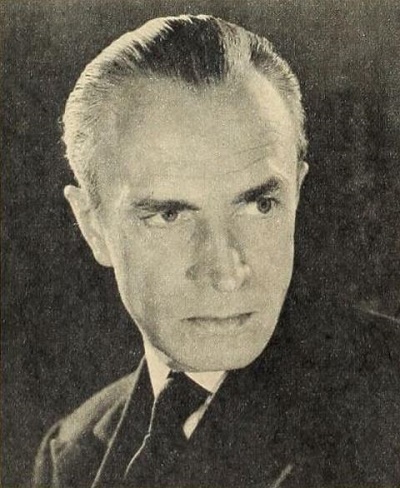
Conrad Veidt, Hollywood, February 1943, page 32
Chess in the Movies by Bob Basalla (C.N. 3986) mentions in connection with Veidt A Man’s Past (1927), Le joueur d’échecs (1938) and The Thief of Bagdad (1940).
In Le joueur d’échecs Veidt played the role of von Kempelen. Below are two photographs from the Sketch, 22 June 1938, page 599:
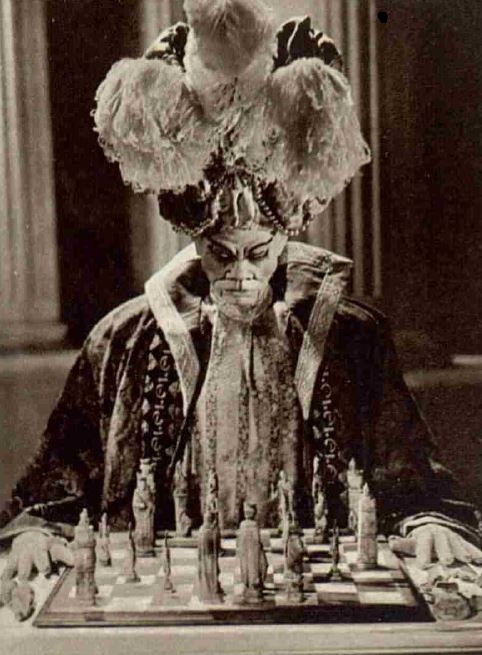
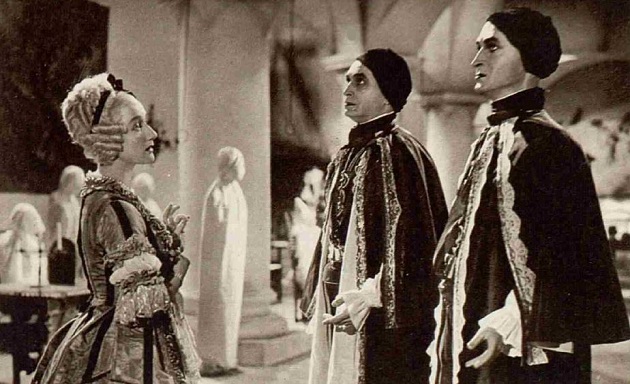
10500. New York, 1915
The photograph of participants in New York, 1915 discussed in a feature article was published on page 752 of the 8 May 1915 issue of Motography:
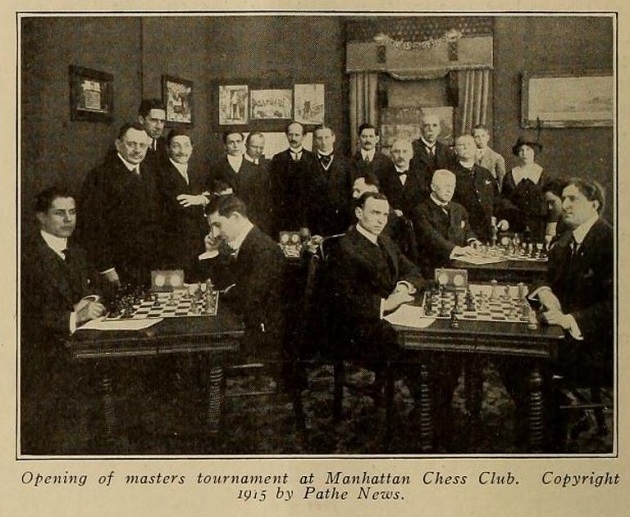
From page 808 of the 15 May 1915 edition:
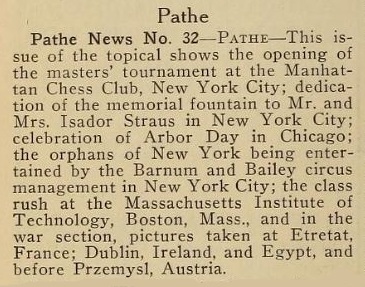
See too Chess Masters on Film.
10501. The Pillsbury Bind
Pages 17-19 of Chess Strategy and Tactics by Fred Reinfeld and Irving Chernev (New York, 1933) gave Pillsbury v Tarrasch, Vienna, 1898, introduced as follows:
‘Beside its historical interest, the game deserves the attention of the student as being the first example of the celebrated “Pillsbury bind”.’
The term was repeated after 21...f6:
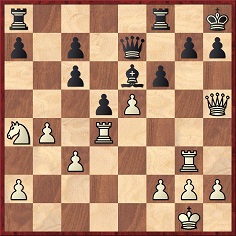
‘22 Kt-B5!
The famous Pillsbury Bind.’
Page 190 of Chernev’s The Most Instructive Games of Chess Ever Played (New York, 1965) had this position and note:
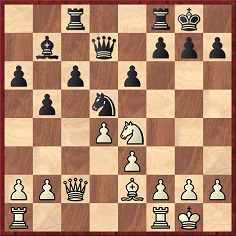
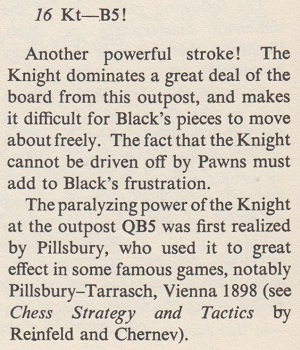
The heading to the game, on page 189:

The concluding note to Rubinstein v Salwe, Łódź, 1908 on page 28 of Chernev’s The Golden Dozen (Oxford, 1976):
‘Rubinstein’s superb technique in exploiting QB5, the key square in the “Pillsbury bind”, would have delighted Pillsbury himself, who showed its power in his famous game against Tarrasch in the play-off match for first prize in the great Vienna, 1898 tournament.’
An early occurrence of the ‘Bind’ term is on page 125 of the June 1909 American Chess Bulletin, in a note to 16...Qa5 in the eighth match-game between Capablanca and Marshall:

Position after 16 Nc3-a4
‘He cannot castle, as Q-B4 would win a pawn. White has established a position akin to the Pillsbury “bind” and that is tantamount to a winning game. It goes without saying that the queen cannot be thus misplaced without seriously compromising his chances.’
A feature on the inside front cover of the April 1958 Chess Review had a diagram after 1 e4 e5 2 Nf3 Nc6 3 Bb5 Nf6 (Showalter v Pillsbury, eighth match-game, 1897) with a note which began:
‘Black has set up the Berlin Defense which his own “Pillsbury Bind” was later to knock out of popularity.’
On page 220 of the October 1965 Chess Life John W. Collins used ‘Pillsbury’s Bind’ to describe 4 Bg5 after 1 d4 Nf6 2 c4 e6 3 Nc3 d5, but the usual term for an early Bg5 in the Queen’s Gambit Declined is the ‘Pillsbury Attack’. See, for instance, pages 78 and 93 of Dynamic Chess by R.N. Coles (London, 1956). A curiosity is that on page 35 of the Hastings, 1895 tournament book Gunsberg wrote regarding the Pillsbury v Tarrasch game, which began 1 d4 d5 2 c4 e6 3 Nc3 Nf6 4 Bg5:
‘No good results from this early sortie of the bishop. The attack or, perhaps better speaking, would-be attack, differs from similar play in the French Defence, inasmuch as White has not P to K5 at his command. Generally speaking, both the first and the second player in this opening require their queen’s bishop on the queen’s side.’
A related term is ‘the Pillsbury set position’. From page 107 of the January 1908 Chess Amateur, in an openings article by William Cook:
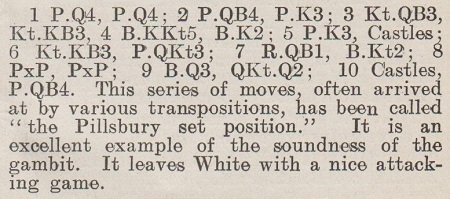
10502. The Immortal Game
Emanuel Lasker’s view of the Immortal Game:
‘It is not very difficult to understand why the “Immortal Game” between Anderssen and Kieseritzky should appeal to the popular mind. Besides the enormous sacrifice of material by White, there is the rare occurrence of all Black’s pieces on the board when he is mated.
The effect of the tremendous labor of the annotators of this game must ultimately result in removing it from the singularly high position in which it has been fixed. The demonstrable fact that White missed a certain win, and that later Black missed a certain draw, practically removes the game from the realms of the classics.
It is a very moot question whether “skittle” games deserve the amount of attention which is bestowed upon them. It may be that irresponsibility and accident produce bewildering, dazzling and even original positions.
“Skittle” playing, as recreation, has a useful function to perform. But, if chess is to be treated as literature, then it is incumbent that the games that are published shall be the product of much thought, of deep imagination, of a sentiment of truth; and above all that the players shall be imbued with a feeling of responsibility, such as follows from tournament or match play.’
The game was then given with detailed notes.
Source: pages 18-20 of the Chess Player’s Scrap Book, February 1907. The periodical, edited by Lasker, was discontinued later that year, after issue 6-7.
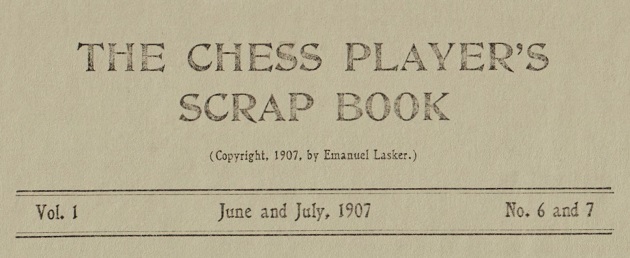
10503. Morphy v the Duke and Count
Page 68 of the May 1907 issue of the Chess Player’s Scrap Book gave the bare score of Morphy v the Duke and Count with the following introduction by Lasker:
‘This is a great game, played against a weak combination. On the eighth move White could have won the QKt pawn, which would have been good enough to win the game, or played BxPch, followed by QxKtP. But that would have been a butcher’s method, not an artist’s.’
Lasker’s butcher/artist remark has often been quoted sourcelessly (e.g. in P.W. Sergeant’s first monograph on Morphy) with reference to 8 Bxf7+, and not also 8 Qxb7.
10504. De Vere
A game played at the odds of pawn and two moves (remove Black’s f-pawn):
1 e4 ... 2 d4 c5 3 Qh5+ g6 4 Qxc5 Nc6 5 d5 e6 6 d6 b6 7 Qg5 Qxg5 8 Bxg5 Bxd6 9 Nf3 h6 10 Bd2 Nf6 11 Bd3 e5 12 Nc3 Nb4 13 a3 Nxd3+ 14 cxd3 Ba6 15 Ke2 Bc7 16 Rac1 Rc8 17 b4 Ke7 18 b5 Bb7 19 Nd1 d5 20 Bb4+ Ke6 21 Nd2 dxe4 22 dxe4 Nxe4 23 f3 Nxd2 24 Bxd2 Bd6 25 Ne3 Bxa3 26 Ra1 Bc5 27 Rxa7 Rh7 28 Ra2 Rd7 29 Rc1 e4 30 f4 h5 31 h3 Rd3 32 g4 hxg4 33 hxg4 Rh8 34 f5+ gxf5 35 gxf5+ Kf6 36 Rf1 Rh2+ 37 Rf2 Rxf2+ 38 Kxf2 Bc8 39 Ke2 Bxf5 40 Ra4 Bg6 41 Ra2 Bh5+ 42 Kf2 Be8 43 Rb2 Bd4 44 White resigns.

With no particulars other than the players’ names (Watts v De Vere) the game was on page 70 of the Chess Player’s Scrap Book, May 1907 with this introduction by Lasker:
‘Elegance is writ large over this game at the odds of pawn and two moves. To begin with, the odds giver does not demur to exchanging queens, efforts to avoid which being the cause of the loss of many games at odds. The beauty of the game does not depend upon any manoeuvre or move. Black simply obtains a gradual mastery over the position until at the finish we see a beautiful little miniature. White can move nothing without serious loss.’
The game is on page 110 of the monograph on Cecil De Vere, “The English Morphy?” by Owen Hindle and Bob Jones (Exmouth, 2001), White being identified as J.J. Watts and the occasion specified as ‘City of London Chess Club – 1871. Handicap Tournament’.
Another game in that book, De Vere’s short win over Minchin (‘Westminster Chess Club, 8 November 1871’ – see page 113), was given by Lasker on page 33 of the Chess Player’s Scrap Book, March 1907 without notes but with this introduction:
‘From the fact that games finished in a few moves generally contain at least one very bad move, we are often led to believe that bad play is essential in the production of a short game. Whatever dispels an illusion is something to be thankful for. We see nothing in this game until it is all over to warrant any expectation that a crisis was so near. The experience gained in playing over such games demonstrates the weakness of the seductive P-KR3 to a remarkable degree.
From that point of view this game deserves studying. The final problem-like position is interesting and curious.’
1 e4 e5 2 Nf3 Nc6 3 Bb5 Nf6 4 O-O Nxe4 5 Re1 Nd6 6 Nxe5 Be7 7 Nc3 O-O 8 d4 Bf6 9 Bd3 h6 10 Nd5 Ne8 11 Qg4 d6 12 Qe4 g6 13 Nxf7 Rxf7 14 Qxg6+ Kf8 15 Bxh6+ Bg7 16 Qh7 Ne7 17 Qh8+ Ng8 18 Bh7 Resigns.

10505. Lasker on the Immortal Chess Problem
Page 74 of the Chess Player’s Scrap Book, May 1907:
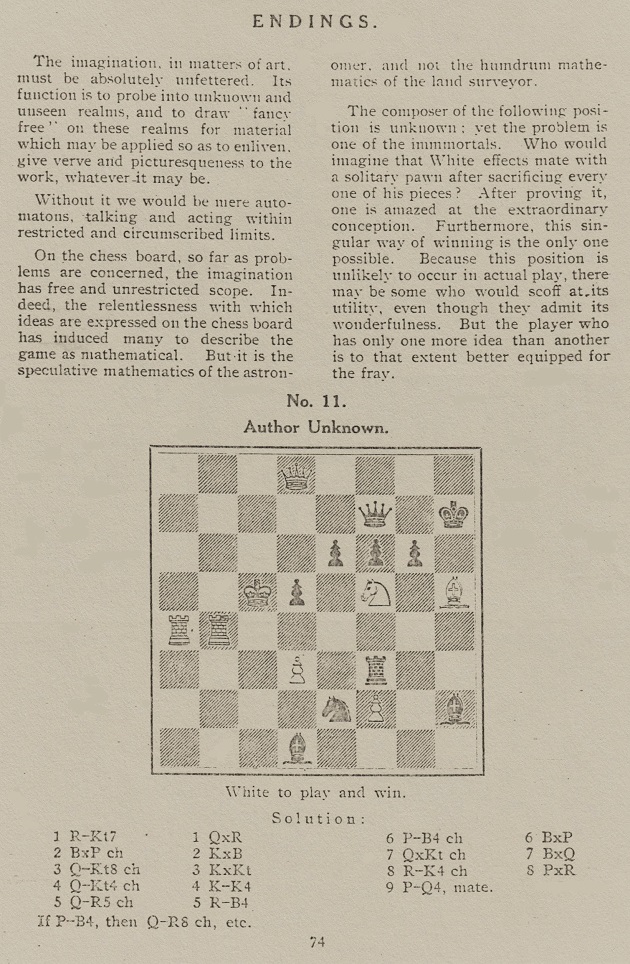
We have prepared a feature article, The Immortal Chess Problem, on Konrad Bayer’s composition.
| First column | << previous | Archives [155] | next >> | Current column |
Copyright: Edward Winter. All rights reserved.
